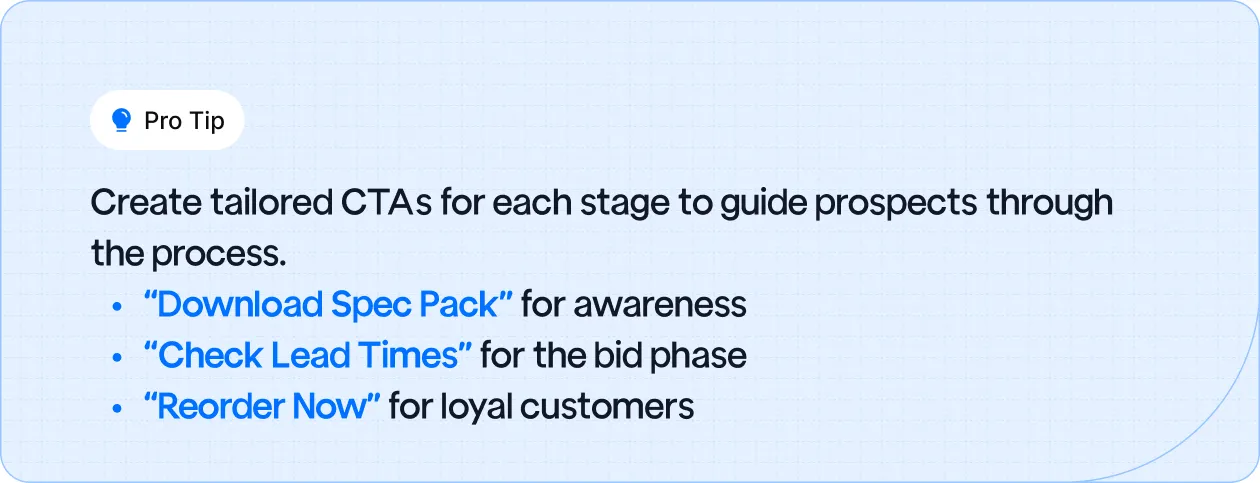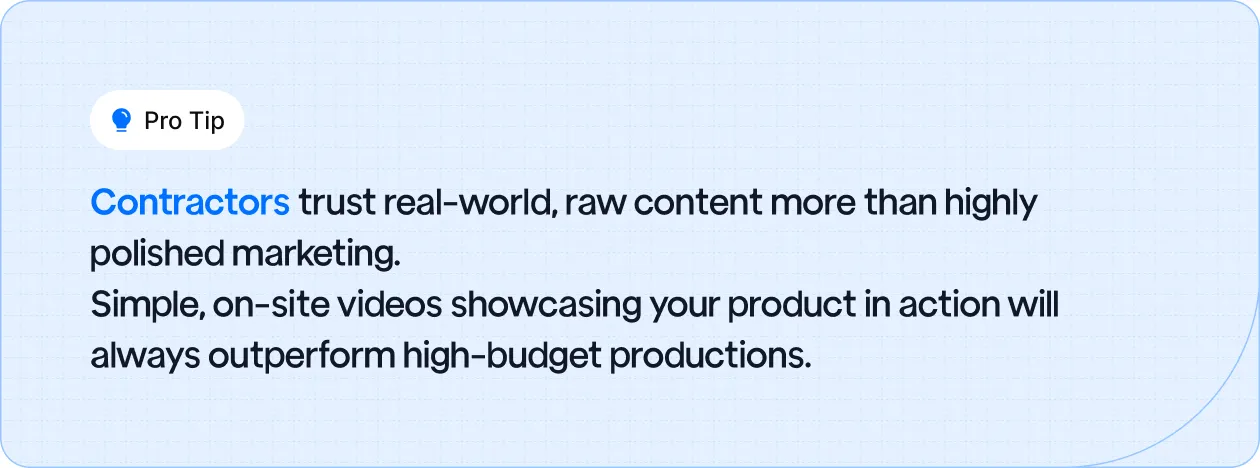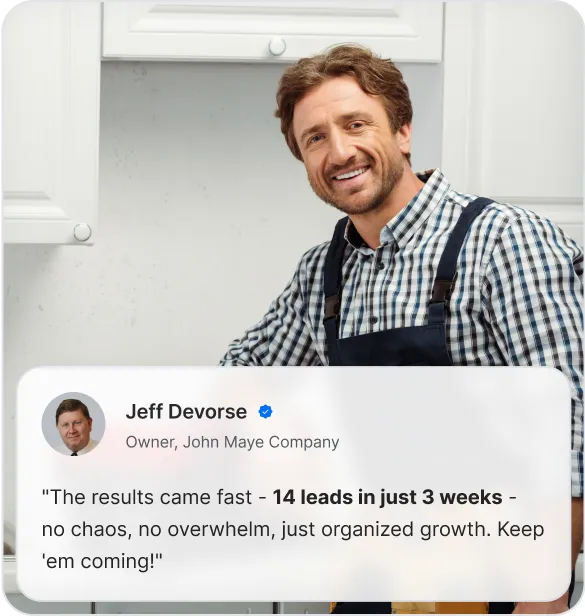As a building material supplier, you know that attracting the right buyers is more than just generating traffic.

Contractors, architects, and dealers require specific, high-quality materials that meet their exact needs, and they often prioritize suppliers who understand the intricacies of their projects. Simply casting a wide net in your digital marketing can lead to wasted resources and missed opportunities.
This guide will show you how to fine-tune your marketing approach to target the right audience, those who are actively searching for materials like yours, helping you generate qualified leads that are more likely to convert into valuable business.
Who’s Actually Buying Your Stuff? (Speak to the Architect, Contractor, Dealer, Not the Void)
To stand out in the crowded building materials market, you need to speak directly to the key decision-makers who influence purchasing decisions.
Broad messages rarely work; instead, target your content to address the specific challenges faced by architects, contractors, and dealers.
Architects & Engineers: Architects and engineers look for materials that not only meet aesthetic and functional requirements but also reduce design risks. Their focus is on how your materials will integrate into their designs without compromising safety, sustainability, or compliance.
Highlighting BIM/Revit files, CSI 3-part specs, and certifications like UL demonstrates your understanding of their rigorous demands.
Contractors & Installers: Contractors are always looking for ways to save time and minimize complications on the jobsite.
Your marketing should offer install videos, failure-mode fixes, and calculators that help contractors work more efficiently and avoid costly mistakes during installation.
Dealers & Distributors: Dealers need to sell fast and keep inventory moving. Help them achieve this by offering co-op kits, co-branded landing pages, and lead routing solutions that attract and convert customers quickly. Providing these assets makes it easier for dealers to market your products and close sales.
Market Every Stage of the Funnel or Lose the Job

Every buyer goes through a unique journey, and if you’re not engaging with them at each stage, they may slip through the cracks. From initial awareness to post-purchase loyalty, marketing at each stage of the funnel is crucial.
Top of the Funnel: At this early stage, prospects are still gathering information. Offering spec packs and detailed product descriptions helps introduce your materials and educates potential customers on their value.
This is the time to build awareness and trust.
Bid Phase: When prospects are ready to make purchasing decisions, they’ll want to know more about lead times, availability, and pricing.
Providing lead-time pages and value engineering (VE) guides addresses their concerns and helps them see how your products fit within their project timelines and budget.
For Existing Customers: Once a customer is on board, the goal is to keep them coming back. Offering reorder flows and reminders for regular maintenance or seasonal needs ensures they return for repeat purchases, strengthening customer loyalty.

Build a Website That Captures Specs and Closes Sales
A website that simply showcases products won’t drive conversions on its own. To succeed, your website needs to capture leads, engage visitors, and ultimately convert them into paying customers.
- Product Detail Pages (PDPs): Your PDPs should go beyond basic product descriptions. Include spec ZIPs, tech sheets, installation instructions, and videos that provide the depth of information needed for architects, contractors, and dealers to make informed decisions. A well-designed PDP builds confidence in your product’s quality and usability.
- Dealer Locator: If your product is available through dealers, make it easy for customers to find them. A click-to-call feature and request quote options will help drive direct communication, increasing the likelihood of sales.
- Navigation & User Experience: Ensure your website’s user experience (UX) is optimized for your target audience. For example, architects should be able to easily access technical specifications, while contractors should find installation guides and time-saving resources immediately.
Post-AI SEO: Technical Excellence, Local Authority, Human-First Content
As AI continues to shape search engine algorithms, your SEO strategy must evolve with it. Effective SEO for building material suppliers goes beyond basic keyword optimization; it involves technical SEO, local authority, and content that serves human needs.

- Technical SEO: Ensure your site is structured for search engines by using faceted navigation for easy filtering of products, applying a canonical strategy to avoid duplicate content, and using HTML twins for PDFs to make your specs easily discoverable by Google.
- Schema Markup: Implementing the right schema (e.g., Product, HowTo, TechArticle, VideoObject, FAQ, LocalBusiness) helps search engines understand your content more deeply and rank it higher for relevant searches.
- Local SEO: For suppliers with multiple locations, multi-location SEO is essential. Create unique branch pages, product catalogs, and ensure your Google My Business (GBP) profiles are fully optimized with product listings, photos, and Q&A sections to build local authority.

Build a Useful Content Strategy: Tools and Resources That Convert
Your content needs to do more than just inform; it should be a resource that helps your audience solve problems and make informed decisions.
BIM/Revit Families & Placement Guides: Architects use BIM/Revit families to integrate your products into their designs. Offering these resources, gated by role, ensures you target the right audience.

- Editable Submittal Packages & CSI 3-Part Specs: These tools are crucial for architects and engineers to specify your products for construction projects. Make these resources readily available and easy to access.
- Jobsite Calculators: Providing practical tools like concrete, drywall, and decking calculators ensures that contractors have everything they need to make quick purchasing decisions.
- Failure-Mode Videos: Contractors benefit from troubleshooting videos and failure-mode analysis. These videos should be embedded on your PDPs to ensure contractors know how to solve common problems quickly.
Platform-Specific Social Media Strategy for Technical Products
Each social media platform serves a different purpose when marketing building materials. Tailor your strategy to the strengths of each platform to maximize engagement.
- LinkedIn: Use Account-Based Marketing (ABM) strategies on LinkedIn to directly target architects and contractors with document ads and case studies that provide in-depth technical details.
- YouTube: Create install videos and how-to guides that provide step-by-step instructions for contractors and builders. These videos can establish your authority and build trust within your community.
- Instagram & Pinterest: These visual platforms are perfect for showcasing before/after photos, crew tips, and real-world application visuals. Focus on user-generated content (UGC) that highlights your products in action on job sites.

Paid Advertising That Tracks to Actual Revenue
Paid advertising is one of the quickest ways to drive traffic to your website, but it’s only effective if you can track its impact on revenue.
- Keyword Focus: Target specific terms that resonate with your audience, like “ASTM E84 [product]”, which directly ties to product compliance and quality.
- Retargeting: Follow up with users who engaged with specific assets, whether spec sheets, installation videos, or the dealer locator, to bring them back into the conversion funnel.
- Attribution Tracking: Import your closed-won data back into Google/Microsoft Ads to calculate true Return on Ad Spend (ROAS) and ensure your ads are delivering tangible results.
Marketplaces You’re Ignoring (and Shouldn’t): ARCAT, BIMobject, Architizer, Thomas
Niche marketplaces offer specialized opportunities to reach qualified buyers. If you're not leveraging these platforms, you're missing out on significant exposure.
- Profile Consistency: Ensure your product profiles on platforms like ARCAT, BIMobject, and Architizer are up-to-date and consistent to build trust and increase visibility.
- UTM Tracking: Add UTM tracking to every download or asset interaction to track where your leads are coming from, enabling you to refine your approach.

Email Marketing: Role-Based Nurtures & Reorder Cadence
Email marketing should never be one-size-fits-all. For building material suppliers, a role-based approach to email nurture campaigns can dramatically improve engagement and conversions. Here’s how you can break it down for each key group:
- Architect Stream: Architects are always looking for new updates, industry codes, and BIM files to integrate into their designs. Keep them engaged by sending:
- Product updates (new materials, technologies, and design trends)
- Compliance updates (building codes, regulations, and new standards)
- BIM/Revit files and editable 3-part specs to make their workflow easier.
- Regular newsletter-style emails that offer insights into how your products align with current or upcoming standards.
- Contractor Stream: Contractors value time-saving resources and efficiency on the jobsite. Email content for contractors should focus on practical guidance:
- Install tips that help them avoid common issues and ensure smooth implementation.
- Warranty steps to inform them about product guarantees, claims, and support.
- Maintenance guides and troubleshooting videos that address common failures and offer solutions.
- Seasonal tips for maintaining materials in different weather conditions or times of the year.
- Dealer Stream: Dealers are focused on inventory management and driving sales. Your emails should empower them to promote your products effectively:
- Promotions and offers, including co-op marketing opportunities.
- Inventory feeds so they can stay informed about product availability and manage stock levels.
- Lead routing info that helps them nurture potential customers.
- Marketing assets such as banners, brochures, and email templates make it easy for them to advertise your products.
- Post-Sample/Install Flows & Seasonal Reorder Reminders: Once a contractor or architect has completed a project or received a sample, it’s the perfect time for follow-up emails:
- Post-installation follow-ups with tips on care and maintenance, and a request for feedback or a review.
- Seasonal reorder reminders to ensure contractors or dealers re-purchase before running low on stock. Offering incentives or discounts for repeat purchases can increase loyalty and sales.
Attribution, Dashboards, and KPIs You Can Defend
The digital marketing landscape for building material suppliers requires a strong attribution model to ensure you’re measuring the right KPIs and making data-driven decisions.
- Stack: CRM, Marketing Automation, Call Tracking, Form Tracking, UTMs: To accurately track and measure marketing success, integrate your CRM with marketing automation tools to capture every lead interaction.
- Use call tracking to track inbound calls from ads and organic search.
- Form tracking ensures you capture form submissions on product detail pages and contact forms.
- Use UTM parameters in URLs to track campaign performance across platforms, ensuring you can attribute lead generation to the right sources.
- KPI Ladder: Building material suppliers should use a KPI ladder that tracks the journey from initial interest to repeat business:
- Spec downloads, measuring interest and engagement.
- Opportunities, qualified leads that have shown a deeper interest.
- Bids, prospects that have received a proposal.
- Purchase Orders (POs), finalized deals.
- Reorder/Lifetime Value (LTV), tracking repeat purchases and customer loyalty.
- Attribution Models: Understand which channels are driving revenue by using:
- Position-based attribution for budget allocation focuses on the first and last interaction points.
- Last-click attribution for operations measures the final touchpoint that led to a purchase.
- Always include offline imports (calls, offline conversions) to ensure you track the full customer journey.
Ship Fast or Get Outpaced: Your 90-Day Plan to Move Product
Building material suppliers need to act quickly to stay competitive. This 90-day plan will ensure that your marketing strategy is in full gear and your products start moving faster.
Days 1-15:
- IA Blueprint: Design an intuitive information architecture (IA) for your website.
- Top 10 PDPs: Identify the top 10 product pages (PDPs) to prioritize and optimize for conversion.
- Branch Template: Create a consistent template for each branch of your business to ensure a unified online presence.
- GBP Cleanup: Optimize your Google My Business (GBP) listings with accurate information, images, and customer reviews.
Days 16-45:
- Launch spec ZIPs and calculators to drive product engagement.
- Start LinkedIn document ads and search campaigns to target your ideal audience.
- Focus on retargeting ads to capture previously engaged visitors.
Days 46-90:
- BIM Launch: Get your BIM files ready and launch to attract architects and engineers.
- Implement role-based nurtures for your email marketing campaigns.
- Upgrade your dealer locator to make it easier for contractors and customers to find you.
- Create 3 case studies showcasing successful projects with your materials to establish credibility.
- Attribution Wiring: Set up clear attribution models to track the effectiveness of every marketing initiative.

Don’t Get Sued: Claims, Compliance, and Warranty Clarity
Legal issues can cost your business time, money, and reputation. Ensure your marketing is compliant and clear to avoid any missteps.
- Test and Certify Claims: Always back up your claims with product certifications and testing results. If your product has specific benefits (e.g., fire resistance, energy efficiency), make sure third-party certifications back these.
- Warranty Conditions: Be upfront about what’s covered under your warranty and any prerequisites for claims. Clearly state:
- Installation conditions: Some warranties only apply if the product is installed correctly.
- Usage guidelines: Specify how and where your products can be used to avoid misuse.
- Claims process: Provide a transparent, easy-to-follow warranty claims process.
Avoid These Expensive Mistakes

In building material marketing, small mistakes can quickly lead to missed opportunities and lost revenue. Here are the key mistakes to avoid:
- No Spec Assets: Without spec sheets, BIM files, and 3-part specs, architects and contractors will look elsewhere. Make sure all your materials are downloadable and up-to-date.
- One-Size-Fits-All Messaging: Stop using the same message for everyone. Tailor your content to your audience: architects need specs, contractors need installation tips, and dealers need sales tools.
- Ignored Branches/GBPs: If you have multiple locations, optimize each branch’s online presence. Google My Business (GBP) optimization is crucial for local SEO.
- PDF-Only Content: PDFs are great, but don’t rely solely on them for engagement. Create interactive content (videos, calculators, etc.) to provide a better user experience.
- No Closed-Loop Revenue Import: Don’t just track leads; connect your sales data back to your marketing campaigns. This ensures you can track what’s really working.
Fixes Listed Point-by-Point:
- Create and maintain spec assets.
- Segment your messaging based on role and needs.
- Optimize all locations and GBP profiles.
- Use multimedia to supplement PDF content.
- Set up closed-loop tracking for ROI measurement.
Ready to Turn Clicks Into Contracts?
Old playbooks, trade shows, brochures, and hope just won’t cut it anymore. The game has shifted; digital is where specs, bids, and reorders are won. It’s no longer about throwing everything at the wall and hoping something sticks.
You need a connected system that integrates SEO, ads, CRM, and spec-grade assets to fuel sustainable growth.
If you’re tired of wasting ad spend and generating unqualified leads, it's time to take control of your marketing and sales cycle. With Gushwork, manufacturers like you can harness a unified approach to drive better results at every stage, from spec generation to reorder.
FAQs
Q1: How can I effectively use SEO to attract qualified leads for my building material business?
A1: Focus on long-tail keywords specific to your products and services, such as "fire-rated drywall suppliers in Chennai." Optimize your website with detailed product pages, downloadable spec sheets, and local SEO strategies to enhance visibility and attract targeted traffic.
Q2: What role does social media play in marketing building materials?
A2: Social media platforms like LinkedIn, Instagram, and Pinterest are valuable for showcasing your products, sharing case studies, and engaging with your audience. Tailor your content to each platform's strengths, professional insights on LinkedIn, visual project showcases on Instagram, and design inspiration on Pinterest, to build brand awareness and trust.
Q3: Is email marketing still relevant for building material suppliers?
A3: Yes, email marketing remains a powerful tool. Segment your audience by role, architects, contractors, and dealers, and send targeted content like product updates, installation guides, and reorder reminders. Personalized emails can nurture relationships and drive repeat business.
Q4: How do I measure the ROI of my digital marketing efforts?
A4: Implement a closed-loop attribution model by integrating your CRM with marketing automation tools. Track key performance indicators (KPIs) such as spec downloads, bids, purchase orders, and reorders. This data-driven approach helps assess the effectiveness of your campaigns and optimize strategies accordingly.
Q5: Should I invest in paid advertising for my building material business?
A5: Paid advertising can be effective when targeting specific keywords and demographics. Utilize platforms like Google Ads and LinkedIn to reach decision-makers. Ensure your ads are aligned with your audience's search intent and provide clear calls to action to maximize conversions.
Q6: How can I enhance my website to convert visitors into leads?
A6: Design your website with user experience in mind. Include detailed product descriptions, downloadable technical specifications, a dealer locator, and easy navigation. Implement clear calls to action, such as "Request a Quote" or "Download Spec Sheet," to guide visitors through the conversion process.





















.webp)








.webp)
.svg)


.svg)
.svg)
.svg)




.svg)




.svg)